Lenovo ThinkCentre M715q Tiny: little wolf in sheep's clothing
Hi, Giktayms! Gartner, IDC, Strategy Analytics - all these analytical companies for the last couple of years have been telling us that the personal computer market is surviving the last few days, and tablets have come to replace the full-fledged PC. Soon the problems began for the latter - a glut of the market sooner or later experiences any successful product, and tablet computers don't have to be updated every year. Allegedly, the trend picked up smartphones, but are they able to satisfy all the needs of the modern user?

Despite the abundance of software for mobile operating systems, many tasks still require a computer. However, if you move away from the gaming direction, then the needs of the average user do not need a large full-fledged PC: run a couple of programs that are not on mobile platforms, or surf the Internet - you do not need a video card with 8 GB of memory and a processor like Intel Core i7 Sandy Bridge. This free market niche was quickly replaced by nettops - compact computers with an optimal ratio of size and power (and prices, of course) that fit into any workplace as if they were not there at all.
The term "nettop" is formed from two words - "Internet" and "Desktop", such computers are essentially stationary analogs of familiar netbooks. In nettops, as a rule, processors with energy-efficient micro-architectures are used, while the technical characteristics are not the most prominent - single-core or dual-core processor, 4 - 8 GB of RAM, 500 GB hard drive, integrated video and sound cards. Nevertheless, this does not prevent millions of customers from using such computers to work on the Internet, watch videos, run programs that are not available on mobile devices, and someone even got the hang of running undemanding games. In addition, nettops are in demand when creating home servers.
')
One of the first term proposed by Intel, since then, many manufacturers began to produce a line of nettops, and Lenovo is no exception. The company has in its arsenal several lines of mini-PCs, and one of the most interesting are the desktop personal computers of the M series in the case of the Tiny form factor. One of these models, the M715q, was on our review today.

Despite its small size, this mini-PC has a wide range of capabilities due to the availability of a modern AMD processor (more on that later), DDR4 memory and rich “detachable” content. But the most important thing is that it takes up almost 96% less space than traditional desktop PCs - the volume of the case is about one liter, and the M715q Tiny literally fits behind the monitor, turning the latter into a monoblock. To do this, simply install the computer inside the back of the display ThinkCentre Tiny-in-One (TIO), which provides the ability to independently upgrade the display and computing resources.
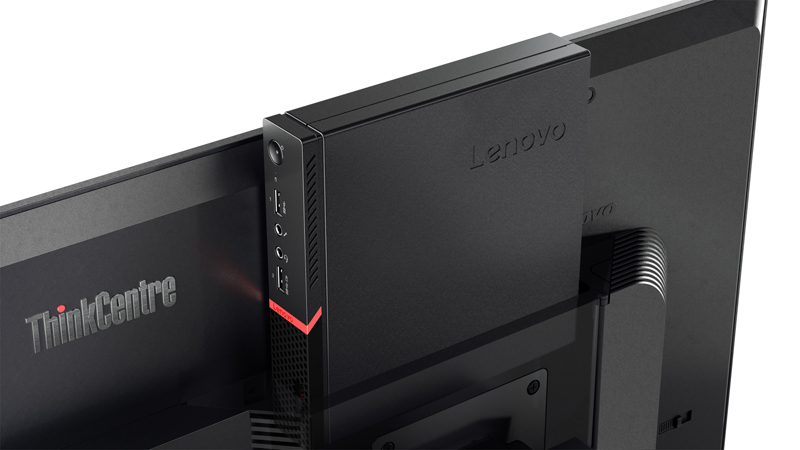
For example, here's how to organize a workspace using this computer and the Lenovo TIO22Gen3 monitor. Remove the plug and simply insert the computer in its place, thereby minimizing the number of wires.
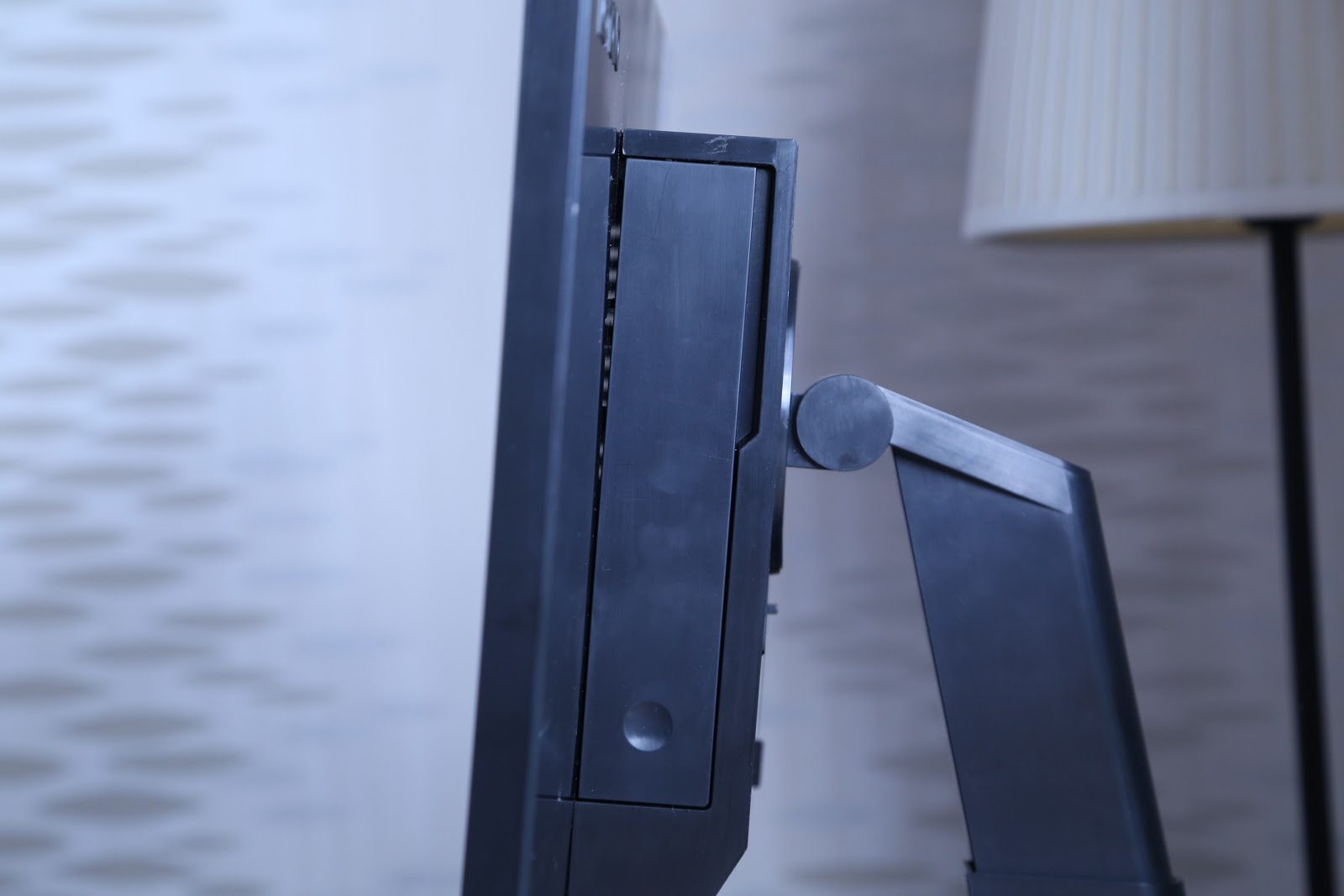
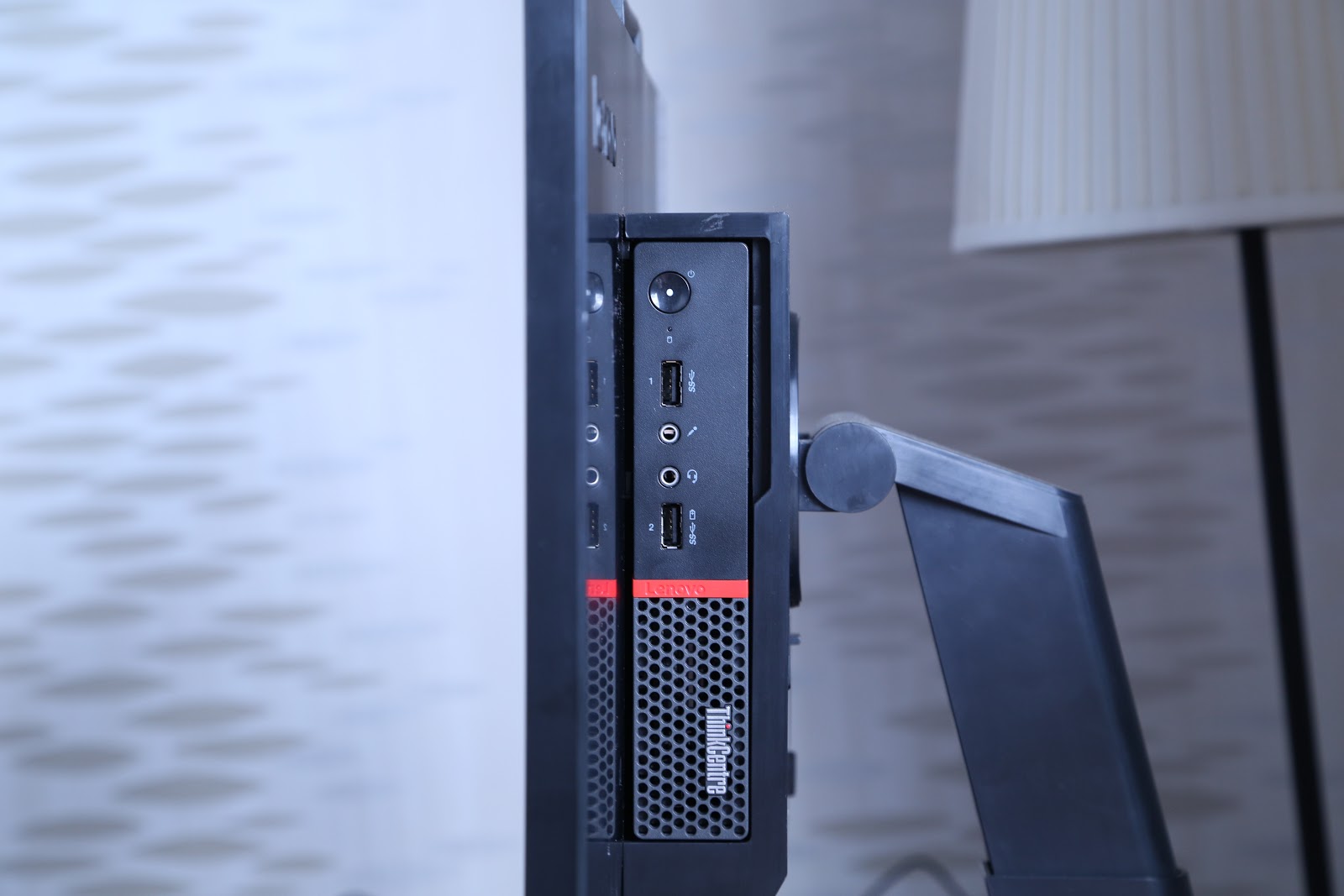
In addition to the standard set of power cables, the package included a fairly simple (but branded) wired keyboard and mouse, Wi-Fi antenna, a set of fasteners, as well as a special metal box in which you can conveniently place the computer both vertically and horizontally to the case It is attached with screws in the kit. If you wish, in principle, you can do without it, but so the design looks much more stable.
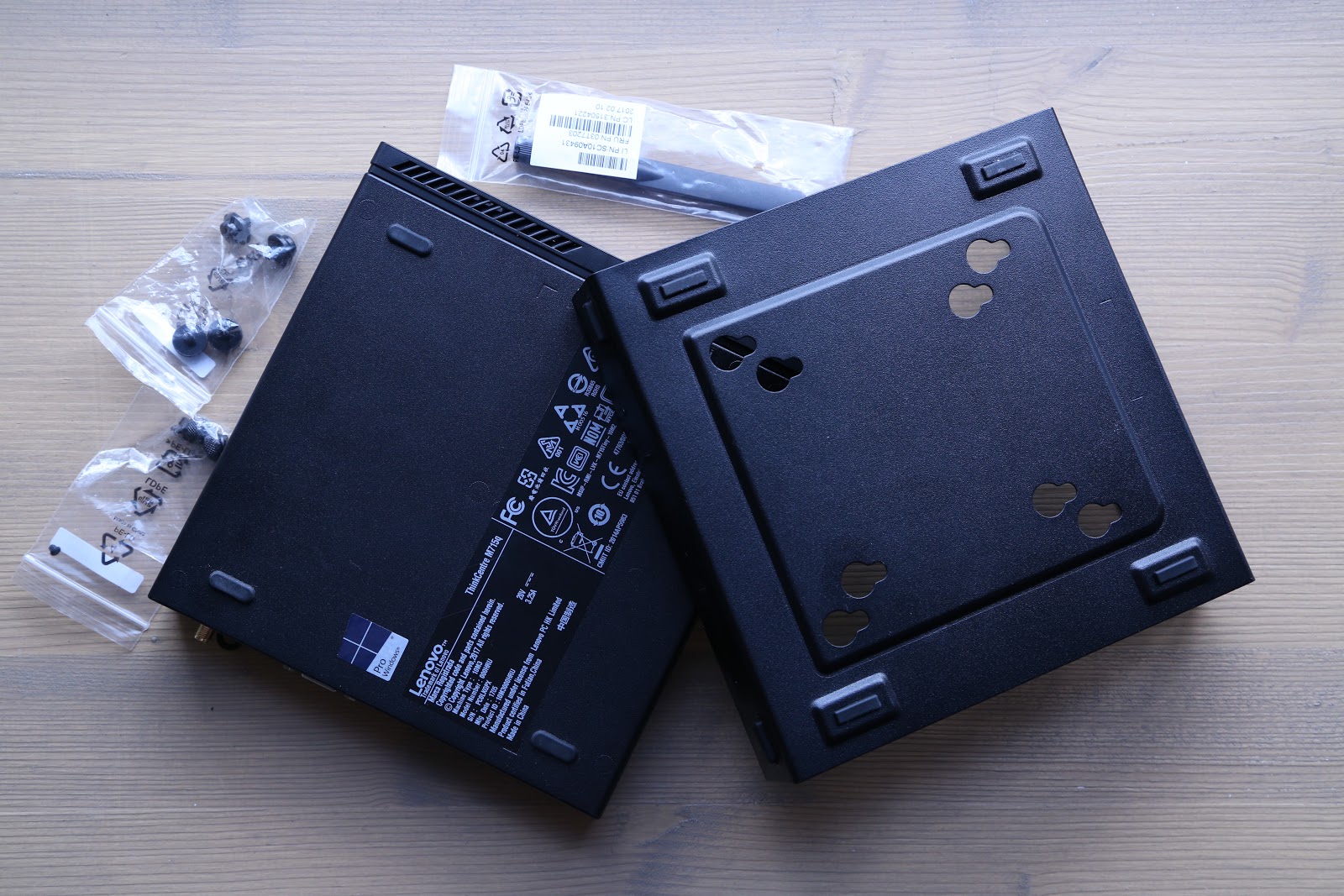


For such a category of computers as nettops, such characteristics can be called flagship - this is not a dual-core processor, 1-2 GB of RAM (for smartphones now and then more!) And only USB 2.0. In the M715q Tiny, the seventh generation AMD processor is used in almost the maximum configuration (an increase in energy efficiency of up to 32% compared to the 6th generation), the DDR4 SO-DIMM 8 GB 2400 MHz latch is responsible for the RAM - all this provides a performance increase of up to 17% compared to previous generation solutions. Integrated graphics - AMD Radeon R7, with GCN architecture and support for AMD FreeSync technology, which eliminates the interruption and freezing of games. And, of course, full combat readiness for DirectX 12, Vulkan, OpenGL 4.5 and Mantle. You can really play this “horse”: medium-sized applications consume applications that run without problems and work without lags, “hard” games, if you are worth the risk of starting, then only at the minimum settings. Yet this is a desktop alternative to a netbook, not a full-fledged gaming computer.



Out of the box, the mini-PC is equipped with a 128 GB solid-state drive M.2, if you wish, you can always replace it with a higher-capacity SSD, install another solid-state drive, as well as a 2.5 ”hard drive at least 1 TB, a slot for it is here provided for.
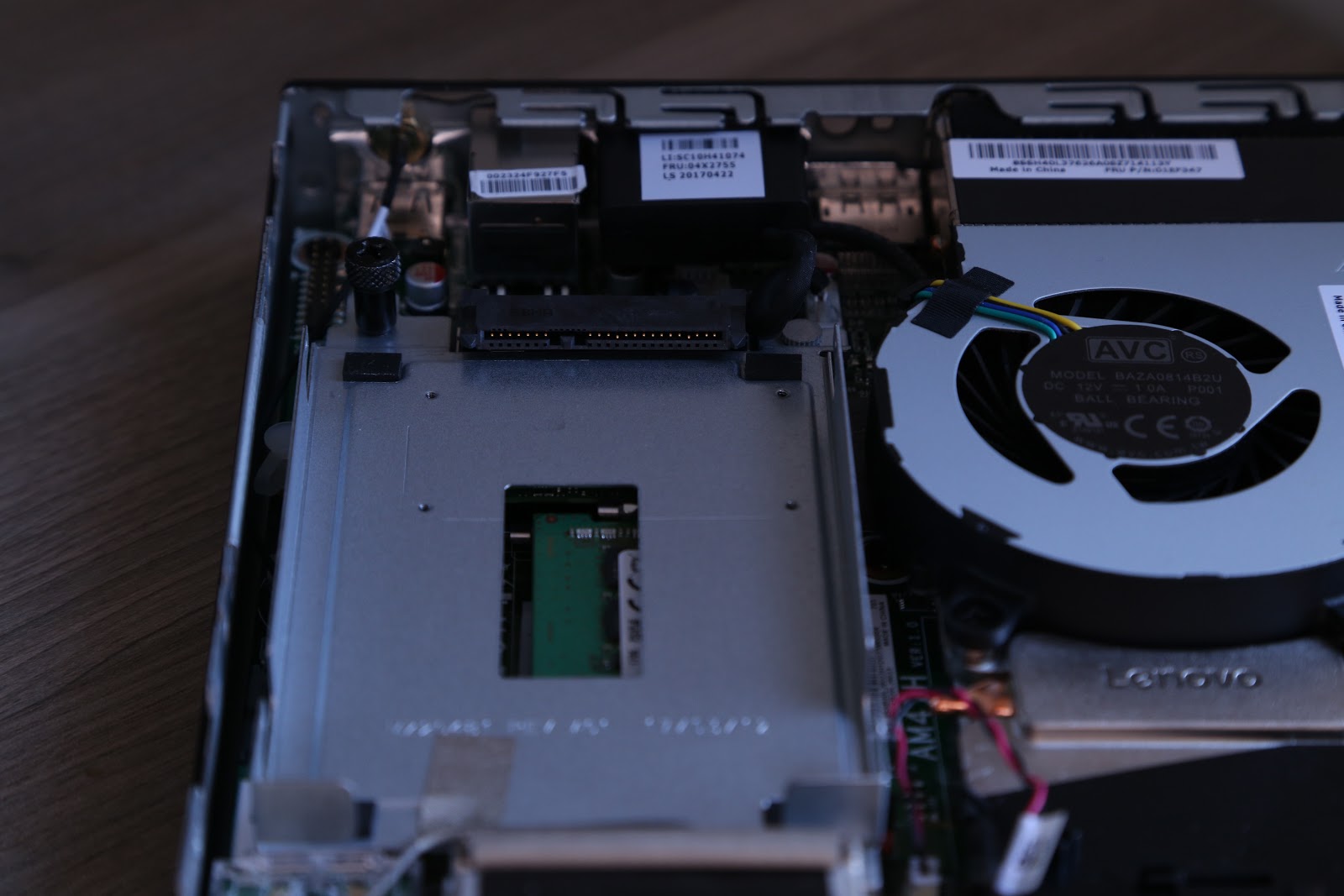
Not without a set of wired and wireless interfaces - 802.11ac Wi-Fi, Bluetooth 4.0, Ethernet. Set, as they say, for all occasions. By the way, you should not forget about installing an antenna for receiving a Wi-Fi signal: many don't even get it out of the box, and then wonder why the wireless connection speed is so small. The abundance of USB ports (and here there are as many as 6) will allow you to connect the required number of devices - connect an external drive, put a smartphone on charge, and an adapter for the same mouse or keyboard. By the way, the “Think” prefix in the device name indicates that it fully complies with military standards and more than 200 quality checks have passed, that is, the range of operating temperatures has been significantly expanded, and the computer itself is resistant to high dust levels. It is useful if for several months did not clean the apartment (joke).
According to observations for several weeks of use - the computer copes with most tasks like working with photos, graphic design, creating content, but for too demanding tasks and processing large amounts of data, power is, of course, not enough. However, with such dimensions and weight, this computer can be forgiven much; yet such solutions are chosen more for the sake of portability than performance. That is why the ThinkCentre M series from Lenovo is in particular demand in the corporate segment, but more on that later.
The first association came very quickly - this mini-PC is comparable in size to a DVD player - its height (and in the supine position - width) is smaller than a regular pencil.
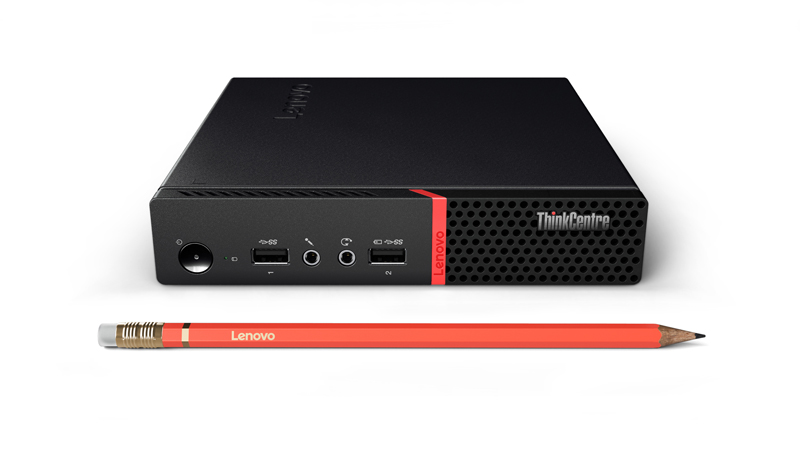
On the front panel there is the logo of the manufacturer and the designation ThinkCentre, under which the holes of the cooling system are hidden (they are also carefully placed on the sides). Above - a USB 3.0 port with support for fast charging, a headset port, a microphone jack, another USB 3.0 and a power button with a performance indicator.
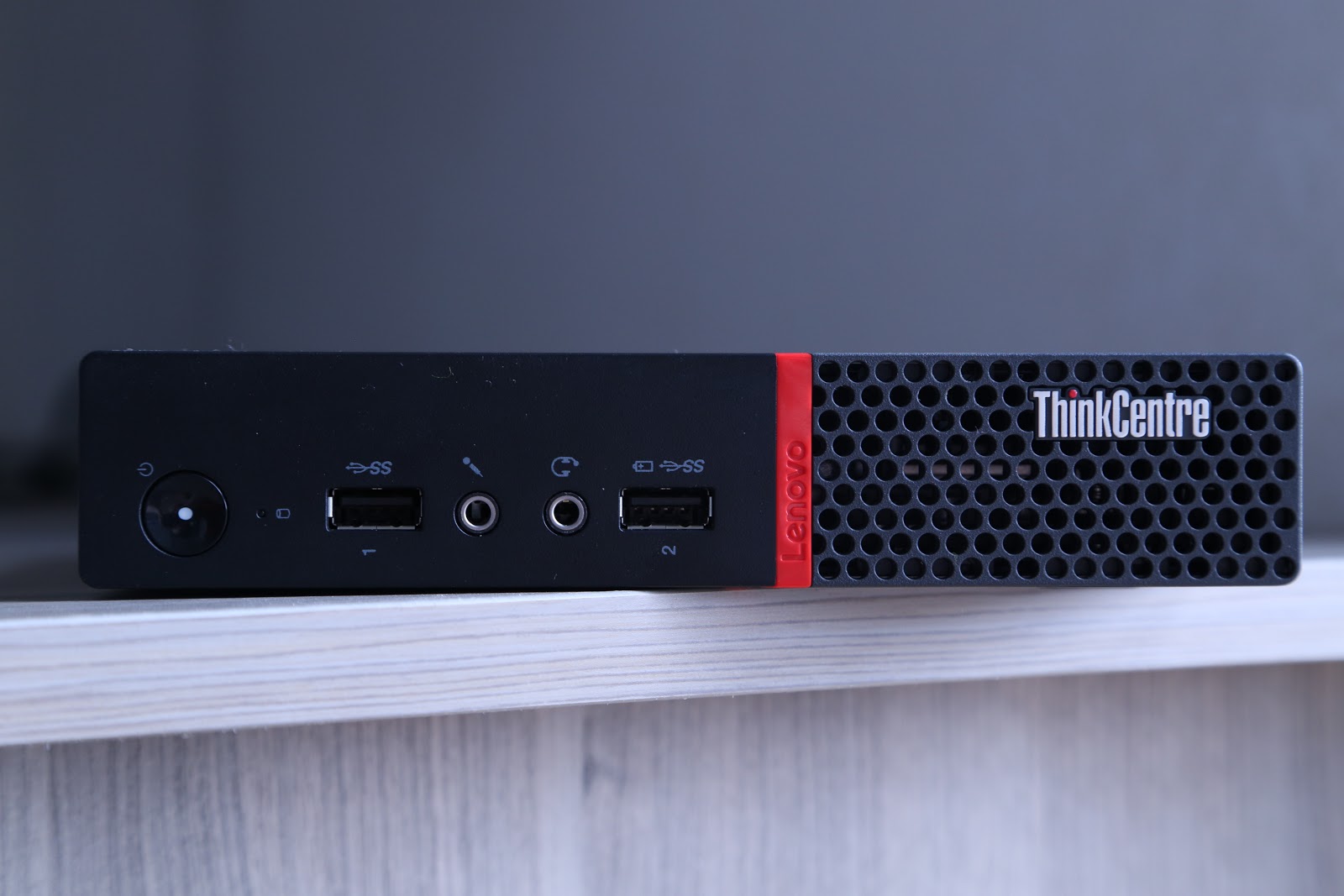
At the back are three more USB 2.0 ports, one USB 3.0 connector, Ethernet, VGA, power, Wi-Fi antenna, and 2 DisplayPort connectors.
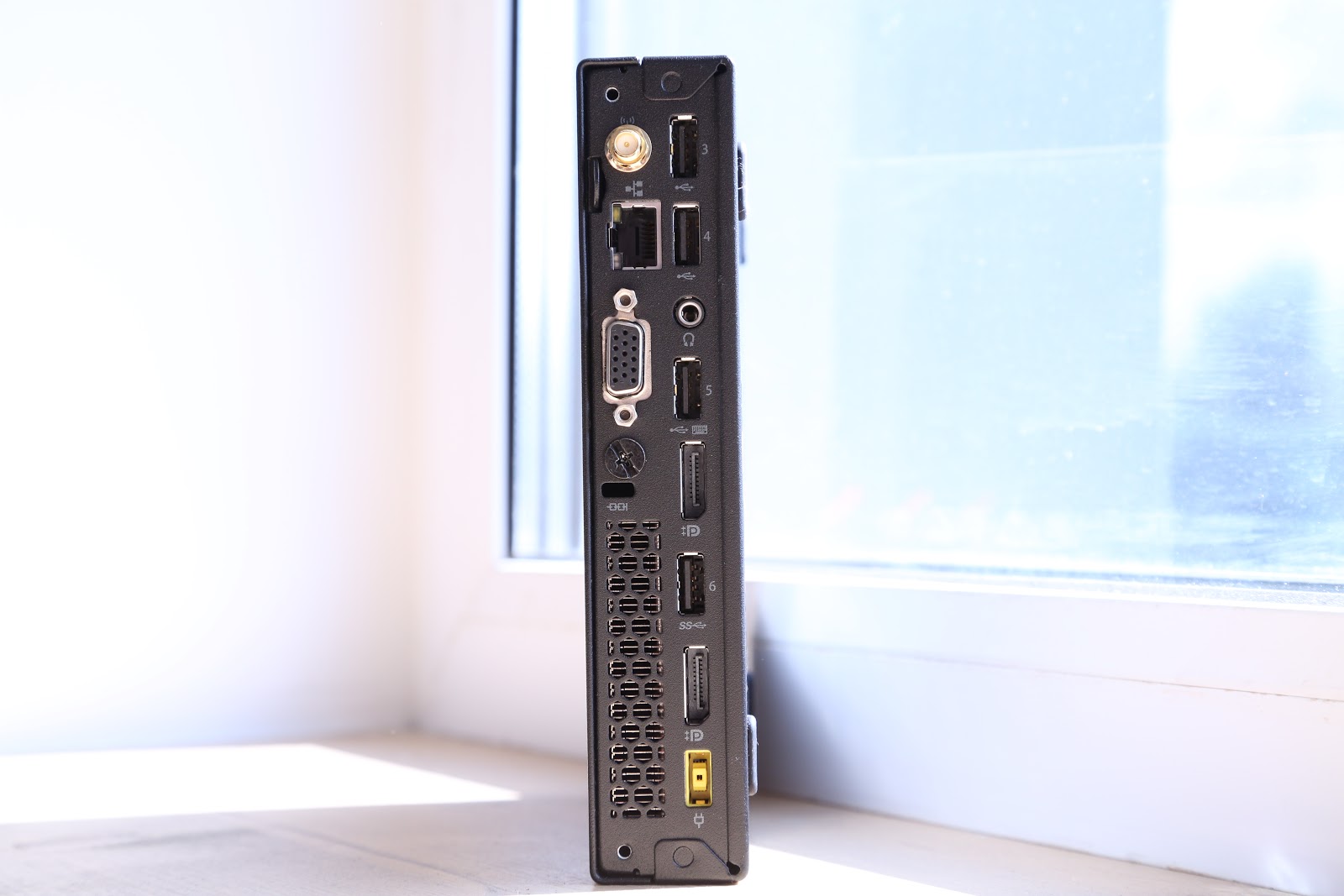
The nettop has an interesting and even slightly futuristic design, while it will easily fit into any interior: if the room is decorated in a minimalist style (like most offices), the computer can be placed directly on the table or hung on the wall - for example, several at once, creating a kind of mini -server. If we are talking about the classics, it will not be difficult to hide such a “baby” - just carefully fix it right under the desktop, and it will be unnoticeable.

On its longest side, the mini-PC almost reaches 183 mm, its width is almost 18 centimeters, and its thickness is only 3.5 cm. The rubber feet on the bottom panel allow the computer to be installed so that it does not slide over the surface, and also reduces vibration. (which is true here, and almost without it). However, you can use the stand in the kit, which we talked about earlier.
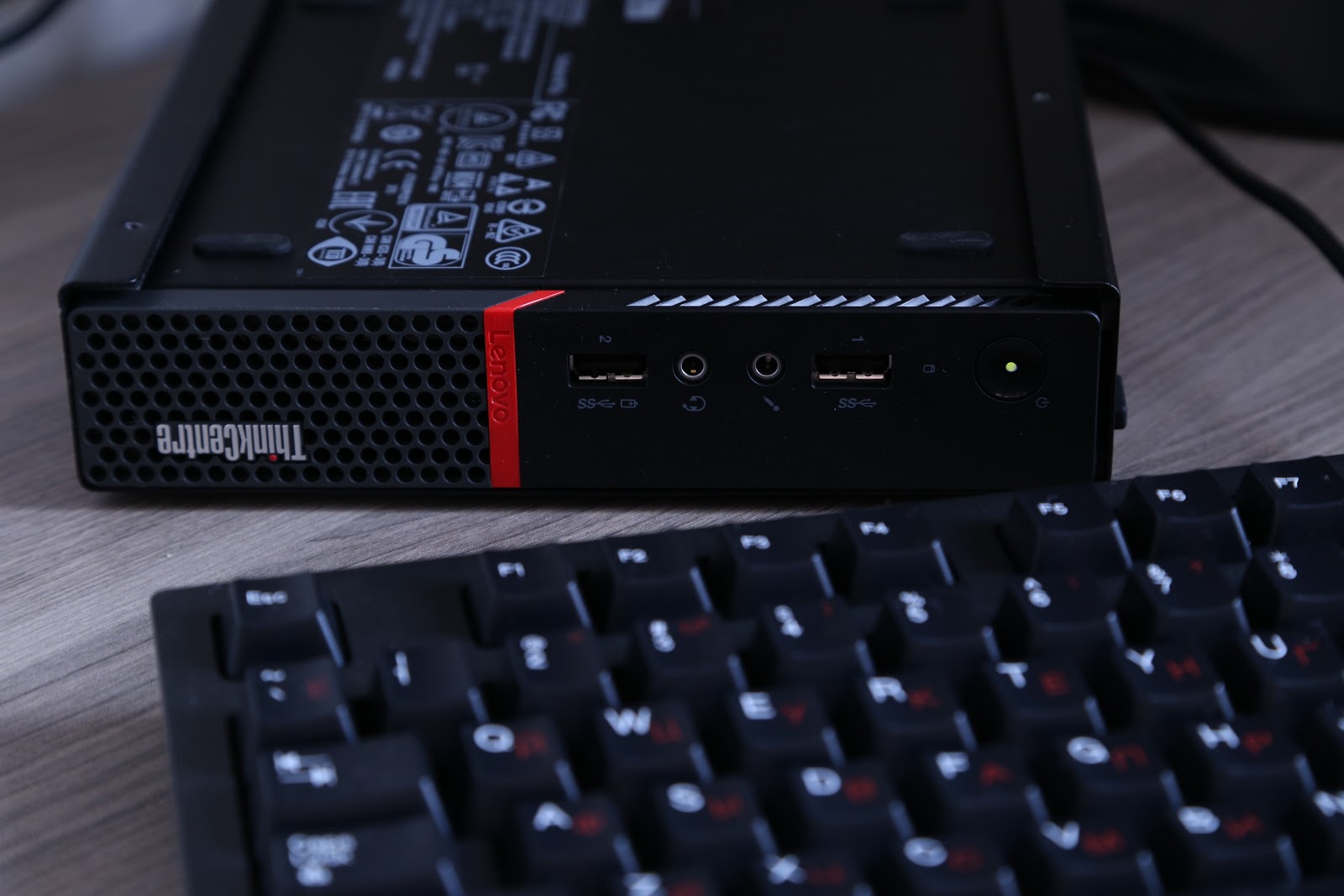
Despite the fact that the manufacturer positions the M715q Tiny more as a corporate PC, it will have to go to the yard and the house without any problems. Yes, you can forget about the "heavy" games and work with video, but the computer copes with the other tasks that have already been described without problems. Unlike netbooks, with which such devices are often compared, the M715q cannot be called a “typewriter”, since its capabilities are far beyond the scope of working with text. Work in the same 1C or edit photos - no problem, as well as adapting a computer for gaming purposes (but without fanaticism). In fact, at first it is difficult to believe that such a compact size hides a device that is quite decent in characteristics. Of course, you can't call him a "wolf" in sheep's clothing, but you can easily call him a "wolf".
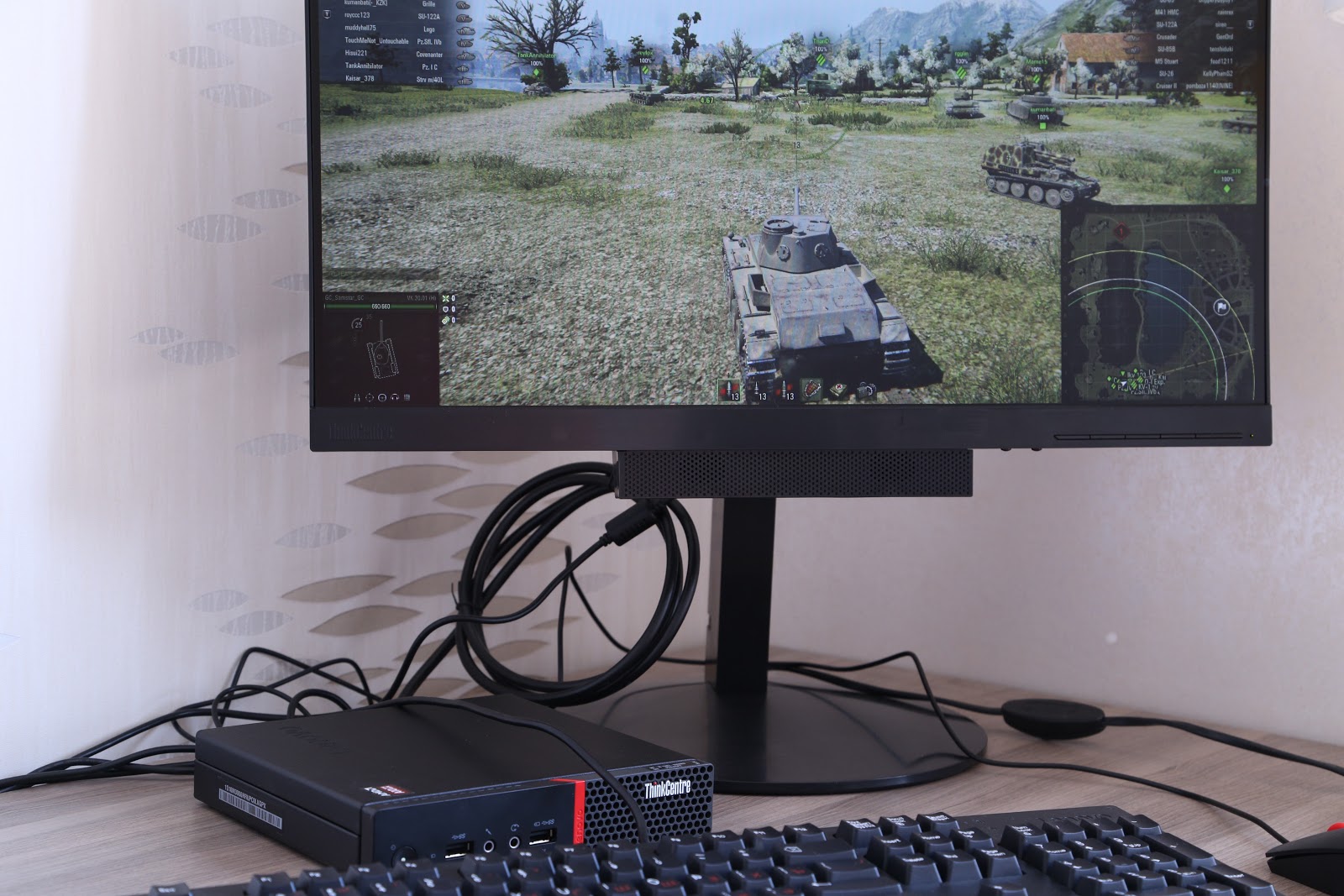
Using the AIDA 6464 utility, we managed to learn something more about the “stuffing” of the computer.

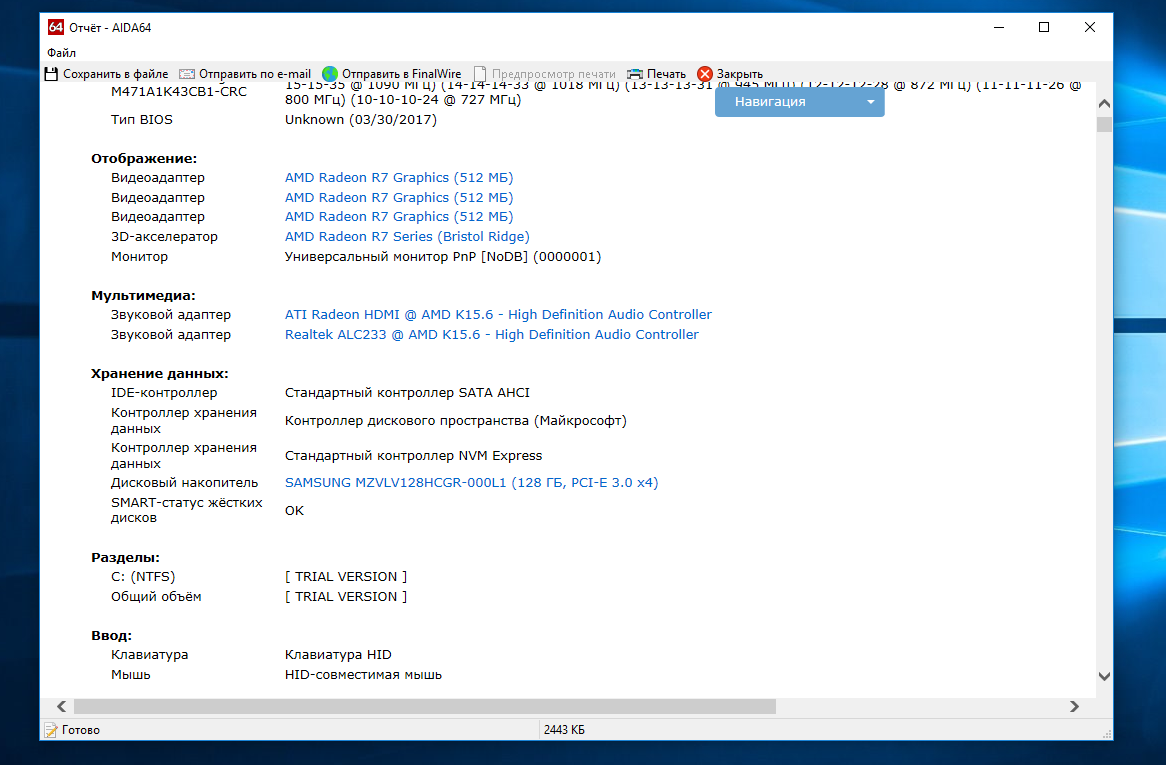
PC3000DiskAnalyzer gave a read speed of about 400 MB / s, the record - 340 MB / s.

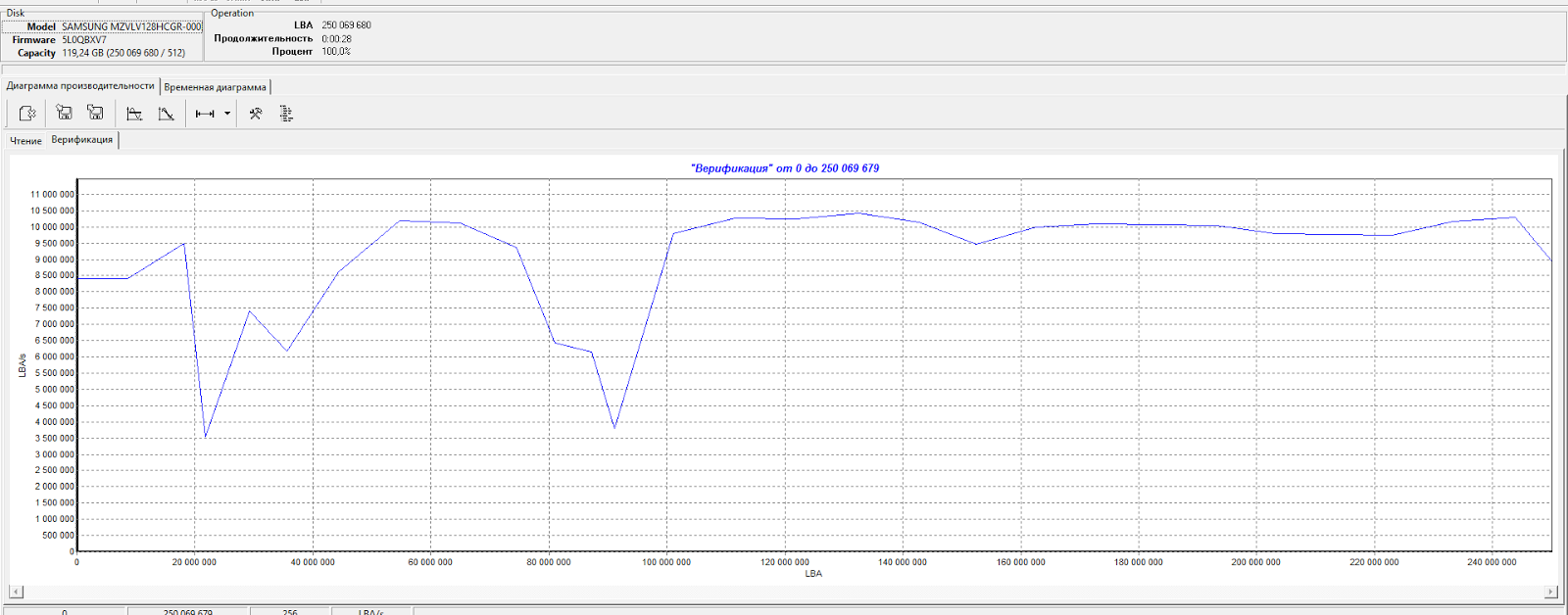
Graphic test using 3DMark 11 showed an average, not the most impressive result.
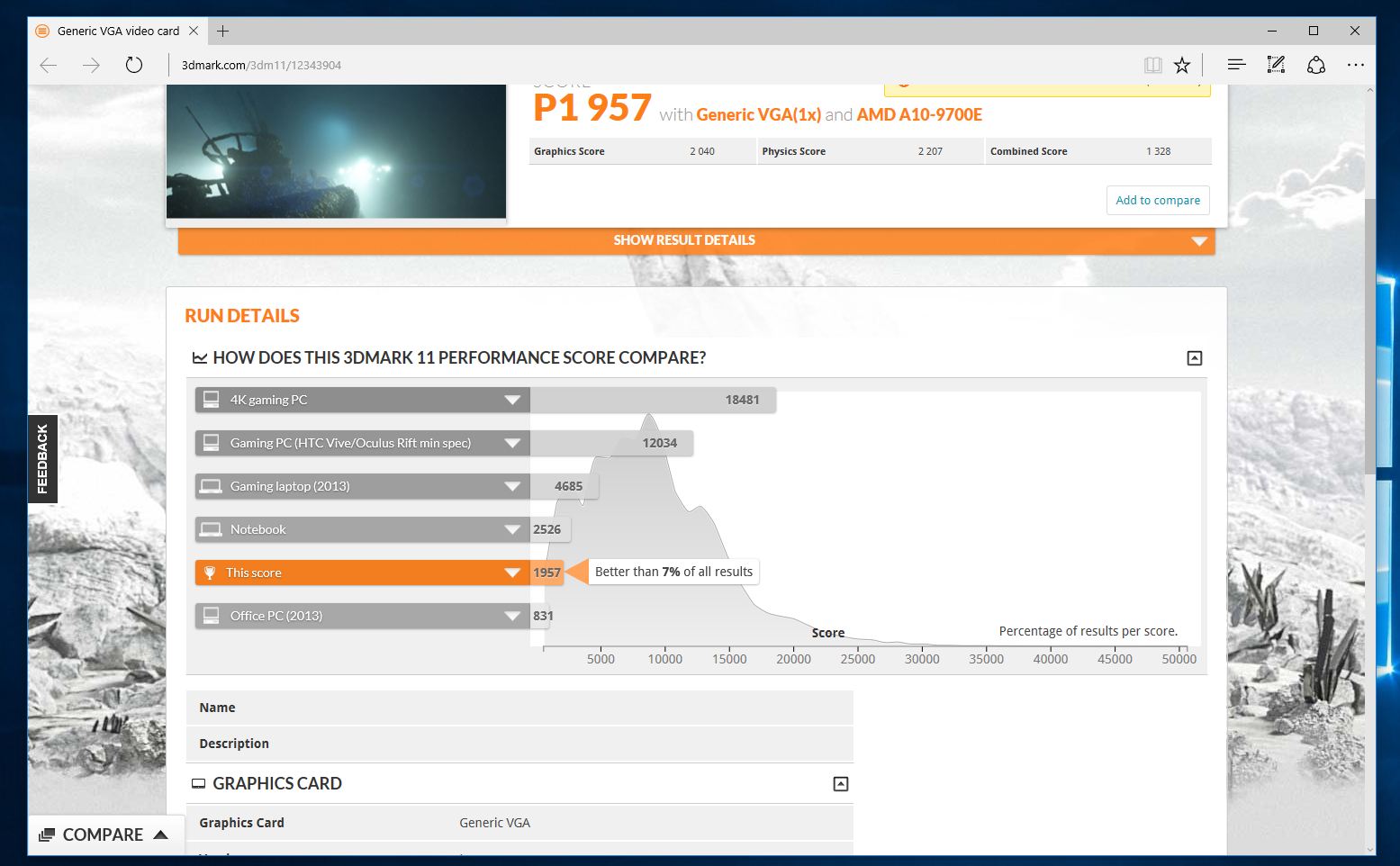
The advantage can be called the fact that the computer, despite its size, is customizable. No one forbids buying a pair of 16 GB DDR4 memory bars and increasing the RAM to 32 GB or replacing the solid-state drive with a model with more memory + add a 1 TB hard drive.
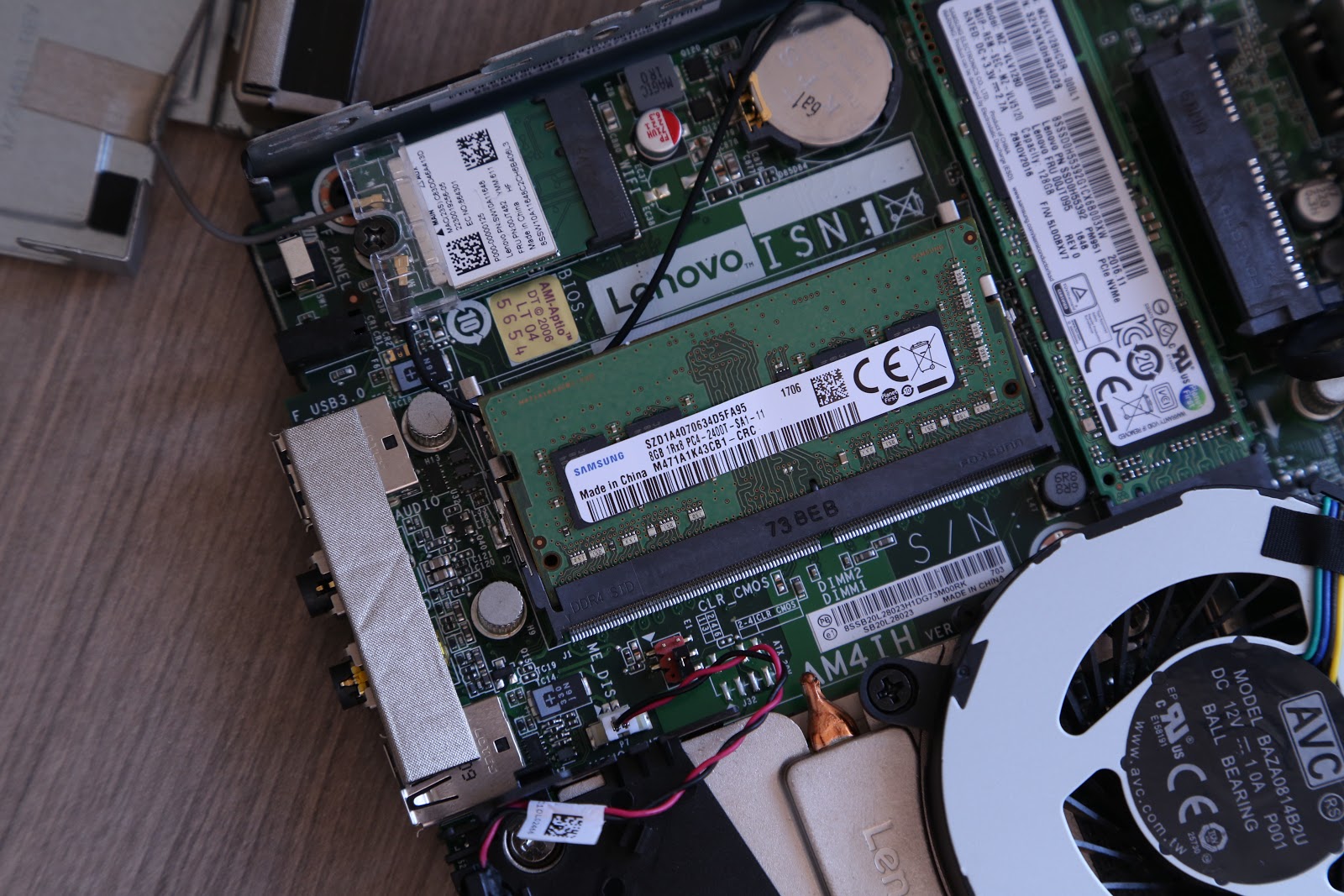
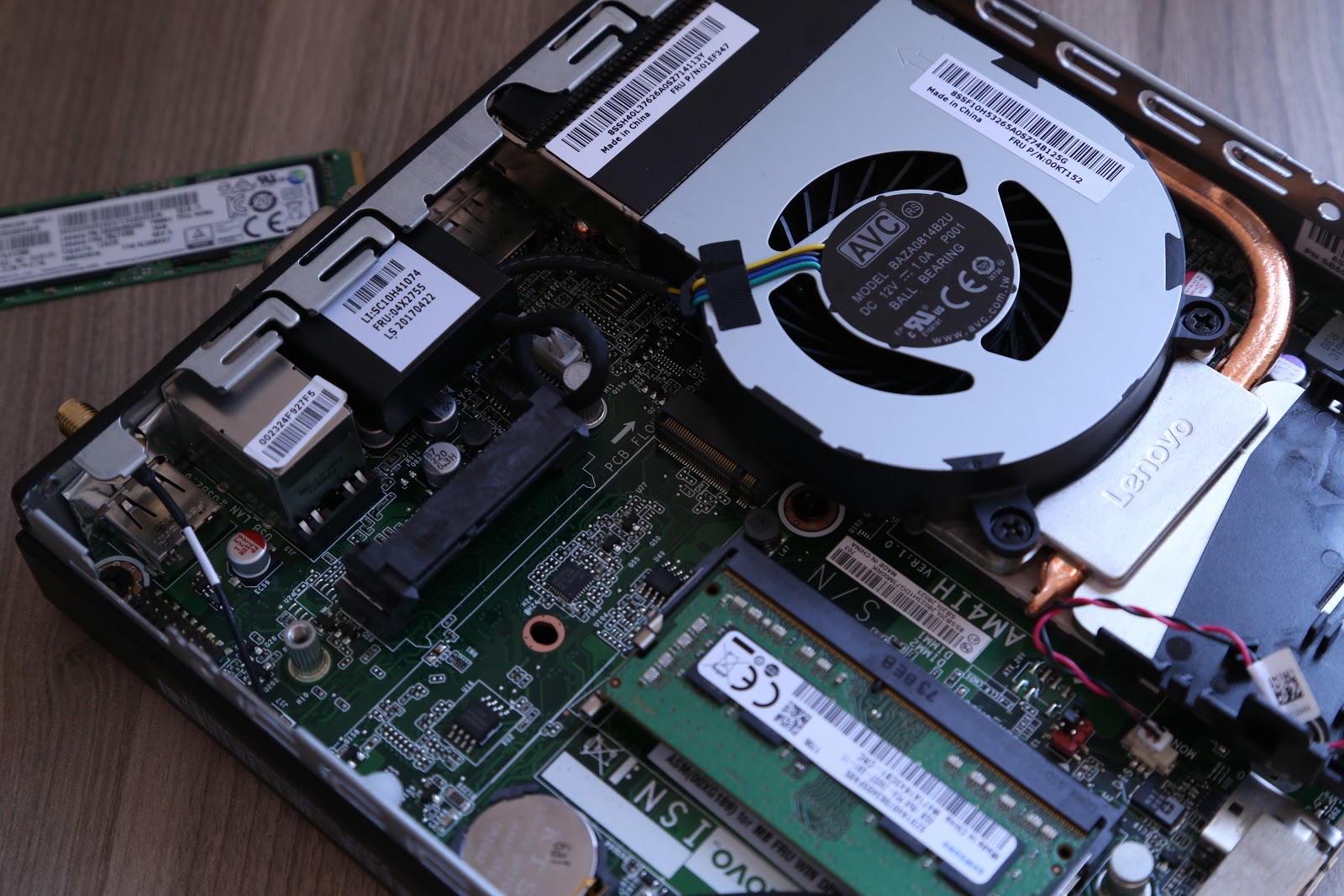
Of course, this is far from a stationary computer, but it is possible to increase the power of the device at a budgetary level, and this is an obvious plus.
After working with the M715q Tiny for several weeks, you can say that many users can easily replace their unit under the table with this box, which is comparable in size to a small book. The computer has an impressive ratio of size and power, which makes him a invited guest both at home and in the office, and in some call-center. There is no confusion with wires and noisy cooling, besides the power consumption of such a device is much lower.
This is not the smallest nettop on the market, however, not on each of these devices you can start the game or edit several photos at once so that the coolers do not try to start the computer into space. There may be questions only about the price - for 25 thousand rubles you can not buy the worst laptop, but here everyone chooses a device according to their needs. If you are looking for a stationary solution that would be powerful and compact, not noisy and with low power consumption, it makes sense to look at our today's guest.

Despite the abundance of software for mobile operating systems, many tasks still require a computer. However, if you move away from the gaming direction, then the needs of the average user do not need a large full-fledged PC: run a couple of programs that are not on mobile platforms, or surf the Internet - you do not need a video card with 8 GB of memory and a processor like Intel Core i7 Sandy Bridge. This free market niche was quickly replaced by nettops - compact computers with an optimal ratio of size and power (and prices, of course) that fit into any workplace as if they were not there at all.
The term "nettop" is formed from two words - "Internet" and "Desktop", such computers are essentially stationary analogs of familiar netbooks. In nettops, as a rule, processors with energy-efficient micro-architectures are used, while the technical characteristics are not the most prominent - single-core or dual-core processor, 4 - 8 GB of RAM, 500 GB hard drive, integrated video and sound cards. Nevertheless, this does not prevent millions of customers from using such computers to work on the Internet, watch videos, run programs that are not available on mobile devices, and someone even got the hang of running undemanding games. In addition, nettops are in demand when creating home servers.
')
One of the first term proposed by Intel, since then, many manufacturers began to produce a line of nettops, and Lenovo is no exception. The company has in its arsenal several lines of mini-PCs, and one of the most interesting are the desktop personal computers of the M series in the case of the Tiny form factor. One of these models, the M715q, was on our review today.

Despite its small size, this mini-PC has a wide range of capabilities due to the availability of a modern AMD processor (more on that later), DDR4 memory and rich “detachable” content. But the most important thing is that it takes up almost 96% less space than traditional desktop PCs - the volume of the case is about one liter, and the M715q Tiny literally fits behind the monitor, turning the latter into a monoblock. To do this, simply install the computer inside the back of the display ThinkCentre Tiny-in-One (TIO), which provides the ability to independently upgrade the display and computing resources.

For example, here's how to organize a workspace using this computer and the Lenovo TIO22Gen3 monitor. Remove the plug and simply insert the computer in its place, thereby minimizing the number of wires.


What is included?
In addition to the standard set of power cables, the package included a fairly simple (but branded) wired keyboard and mouse, Wi-Fi antenna, a set of fasteners, as well as a special metal box in which you can conveniently place the computer both vertically and horizontally to the case It is attached with screws in the kit. If you wish, in principle, you can do without it, but so the design looks much more stable.



Specifications
| CPU | AMD A10 9700E |
| The frequency and number of processor cores | 3.0 GHz, quad |
| Motherboard | AMD B300 |
| RAM | SODIMM, DDR4 8192 MB 2400 MHz |
| Graphics | AMD Radeon R7 |
| HDD | Slot for 2.5-inch drive |
| Interfaces | 802.11ac Wi-Fi, Bluetooth 4.0, Ethernet |
| SSD | M.2, 128 GB, slot for additional. SSD |
| operating system | Windows 10 Pro |
| Connectors | 2 DisplayPort, headphone jack, headset jack, microphone port, Ethernet, VGA, 2 USB 3.0 ports (front panel), 3 USB 2.0 ports, USB 3.0 port (back panel) |
| Body dimensions | 179 x 34.5 x 182.9 mm |
| Weight | 1.3 kg |
For such a category of computers as nettops, such characteristics can be called flagship - this is not a dual-core processor, 1-2 GB of RAM (for smartphones now and then more!) And only USB 2.0. In the M715q Tiny, the seventh generation AMD processor is used in almost the maximum configuration (an increase in energy efficiency of up to 32% compared to the 6th generation), the DDR4 SO-DIMM 8 GB 2400 MHz latch is responsible for the RAM - all this provides a performance increase of up to 17% compared to previous generation solutions. Integrated graphics - AMD Radeon R7, with GCN architecture and support for AMD FreeSync technology, which eliminates the interruption and freezing of games. And, of course, full combat readiness for DirectX 12, Vulkan, OpenGL 4.5 and Mantle. You can really play this “horse”: medium-sized applications consume applications that run without problems and work without lags, “hard” games, if you are worth the risk of starting, then only at the minimum settings. Yet this is a desktop alternative to a netbook, not a full-fledged gaming computer.



Out of the box, the mini-PC is equipped with a 128 GB solid-state drive M.2, if you wish, you can always replace it with a higher-capacity SSD, install another solid-state drive, as well as a 2.5 ”hard drive at least 1 TB, a slot for it is here provided for.

Not without a set of wired and wireless interfaces - 802.11ac Wi-Fi, Bluetooth 4.0, Ethernet. Set, as they say, for all occasions. By the way, you should not forget about installing an antenna for receiving a Wi-Fi signal: many don't even get it out of the box, and then wonder why the wireless connection speed is so small. The abundance of USB ports (and here there are as many as 6) will allow you to connect the required number of devices - connect an external drive, put a smartphone on charge, and an adapter for the same mouse or keyboard. By the way, the “Think” prefix in the device name indicates that it fully complies with military standards and more than 200 quality checks have passed, that is, the range of operating temperatures has been significantly expanded, and the computer itself is resistant to high dust levels. It is useful if for several months did not clean the apartment (joke).
According to observations for several weeks of use - the computer copes with most tasks like working with photos, graphic design, creating content, but for too demanding tasks and processing large amounts of data, power is, of course, not enough. However, with such dimensions and weight, this computer can be forgiven much; yet such solutions are chosen more for the sake of portability than performance. That is why the ThinkCentre M series from Lenovo is in particular demand in the corporate segment, but more on that later.
Appearance
The first association came very quickly - this mini-PC is comparable in size to a DVD player - its height (and in the supine position - width) is smaller than a regular pencil.

On the front panel there is the logo of the manufacturer and the designation ThinkCentre, under which the holes of the cooling system are hidden (they are also carefully placed on the sides). Above - a USB 3.0 port with support for fast charging, a headset port, a microphone jack, another USB 3.0 and a power button with a performance indicator.

At the back are three more USB 2.0 ports, one USB 3.0 connector, Ethernet, VGA, power, Wi-Fi antenna, and 2 DisplayPort connectors.

The nettop has an interesting and even slightly futuristic design, while it will easily fit into any interior: if the room is decorated in a minimalist style (like most offices), the computer can be placed directly on the table or hung on the wall - for example, several at once, creating a kind of mini -server. If we are talking about the classics, it will not be difficult to hide such a “baby” - just carefully fix it right under the desktop, and it will be unnoticeable.

On its longest side, the mini-PC almost reaches 183 mm, its width is almost 18 centimeters, and its thickness is only 3.5 cm. The rubber feet on the bottom panel allow the computer to be installed so that it does not slide over the surface, and also reduces vibration. (which is true here, and almost without it). However, you can use the stand in the kit, which we talked about earlier.

Tests and experience of use
Despite the fact that the manufacturer positions the M715q Tiny more as a corporate PC, it will have to go to the yard and the house without any problems. Yes, you can forget about the "heavy" games and work with video, but the computer copes with the other tasks that have already been described without problems. Unlike netbooks, with which such devices are often compared, the M715q cannot be called a “typewriter”, since its capabilities are far beyond the scope of working with text. Work in the same 1C or edit photos - no problem, as well as adapting a computer for gaming purposes (but without fanaticism). In fact, at first it is difficult to believe that such a compact size hides a device that is quite decent in characteristics. Of course, you can't call him a "wolf" in sheep's clothing, but you can easily call him a "wolf".

Using the AIDA 6464 utility, we managed to learn something more about the “stuffing” of the computer.


PC3000DiskAnalyzer gave a read speed of about 400 MB / s, the record - 340 MB / s.


Graphic test using 3DMark 11 showed an average, not the most impressive result.

The advantage can be called the fact that the computer, despite its size, is customizable. No one forbids buying a pair of 16 GB DDR4 memory bars and increasing the RAM to 32 GB or replacing the solid-state drive with a model with more memory + add a 1 TB hard drive.


Of course, this is far from a stationary computer, but it is possible to increase the power of the device at a budgetary level, and this is an obvious plus.
findings
After working with the M715q Tiny for several weeks, you can say that many users can easily replace their unit under the table with this box, which is comparable in size to a small book. The computer has an impressive ratio of size and power, which makes him a invited guest both at home and in the office, and in some call-center. There is no confusion with wires and noisy cooling, besides the power consumption of such a device is much lower.
This is not the smallest nettop on the market, however, not on each of these devices you can start the game or edit several photos at once so that the coolers do not try to start the computer into space. There may be questions only about the price - for 25 thousand rubles you can not buy the worst laptop, but here everyone chooses a device according to their needs. If you are looking for a stationary solution that would be powerful and compact, not noisy and with low power consumption, it makes sense to look at our today's guest.
Source: https://habr.com/ru/post/373843/
All Articles